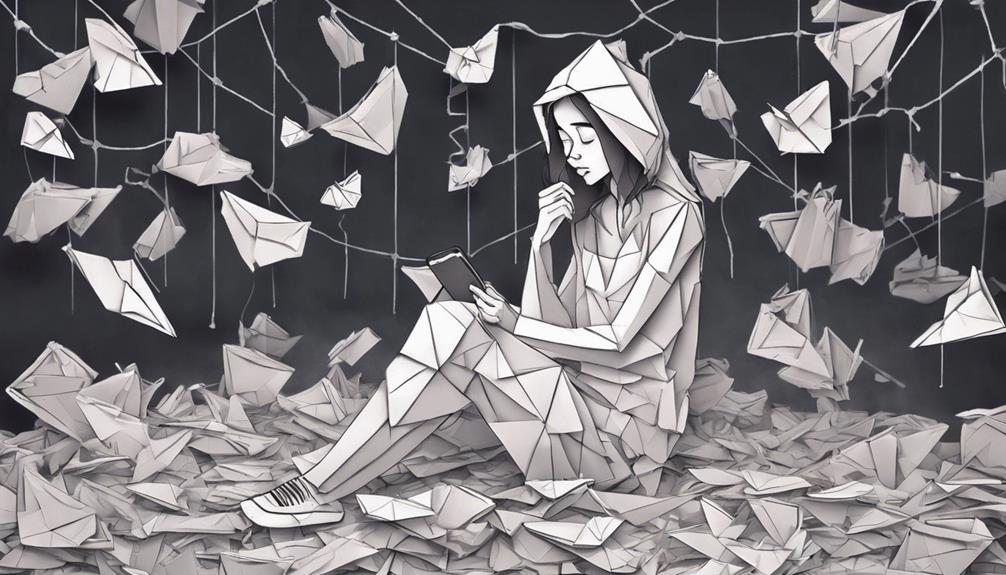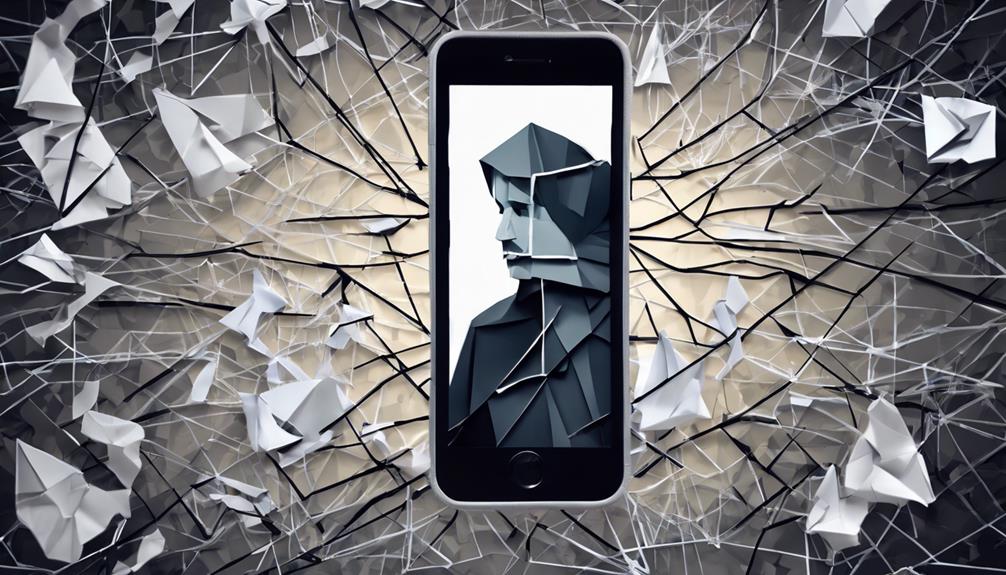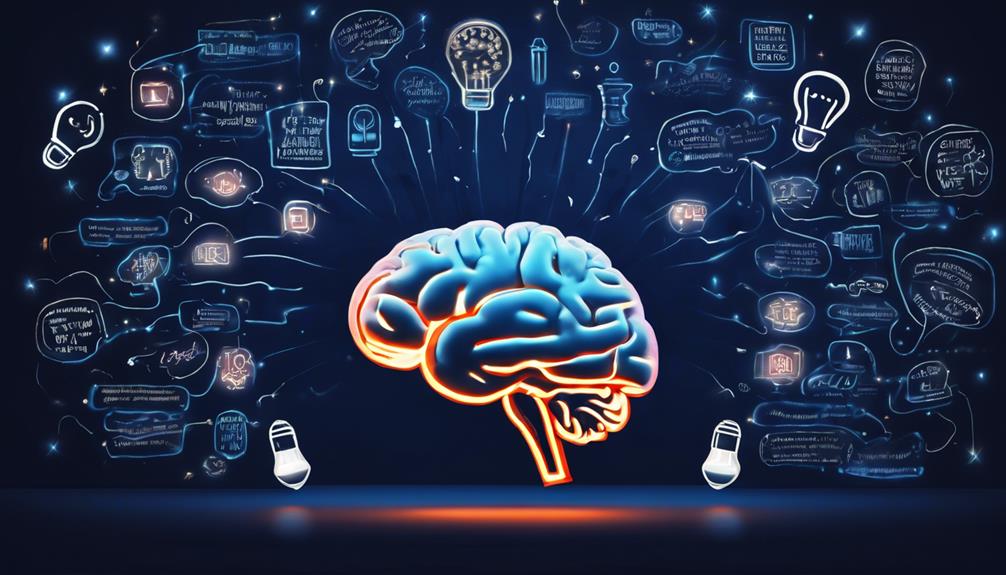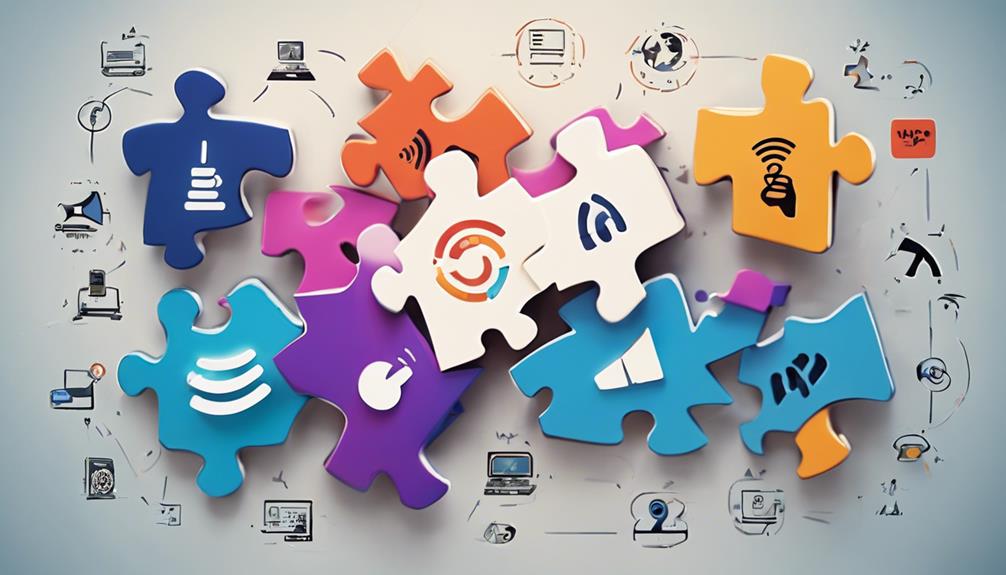Social media's darker side is surfacing, revealing a staggering 59% of U.S. teens have fallen victim to cyberbullying, leading to anxiety, depression, and even suicide. The culture of comparison and unrealistic beauty standards exacerbate feelings of inadequacy, while the pressure to present a perfect online persona downplays mental health concerns. Additionally, social media's impact on communication norms has led to a decline in listening skills, misinterpretation, and conflict. As misinformation and privacy breaches go unchecked, it's clear that social media has ruined society in ways that are only now coming to light – and the truth is only beginning to unfold.
Key Takeaways
- Social media has fueled a cyberbullying epidemic, affecting 59% of U.S. teens, with devastating impacts on self-esteem, mental health, and academics.
- The culture of comparison on social media has led to a rise in anxiety and depression, as users struggle with unrealistic expectations and feelings of inadequacy.
- Excessive social media use has been linked to increased mental health issues, as users prioritize presenting a perfect online life over their well-being.
- The decline in face-to-face interactions and meaningful connections has contributed to a sense of isolation, despite being constantly connected online.
- The spread of misinformation and lack of privacy concerns have further eroded trust in social media, highlighting the need for regulation and education.
Cyberbullying Epidemic Among Teenagers
Approximately 59% of U.S. teens have fallen prey to the pervasive menace of cyberbullying, which has led to a troubling surge in depression, anxiety, and suicide attempts among this vulnerable demographic.
Social media platforms, often touted as harmless, provide a breeding ground for cyberbullies to target teenagers with impunity. The anonymity afforded by these platforms makes it easier for perpetrators to hide behind screens, escalating harmful behavior with relative ease.
As a result, teenagers are often left to suffer in silence, with only 1 in 10 victims reporting the abuse to parents or authorities. Cyberbullying can have devastating, long-lasting effects on teenagers, impacting their self-esteem, mental health, and academic performance.
It's imperative that schools, parents, and authorities take proactive measures to address this growing issue, implementing cyberbullying prevention programs and monitoring tools to safeguard the well-being of teenagers.
Anxiety and Depression on Rise

The essential rise of anxiety and depression among teenagers has been linked to their excessive social media use, which perpetuates unrealistic expectations and a distorted view of reality. Studies have shown that the constant exposure to curated, idealized lifestyles on social media can lead to feelings of loneliness, isolation, and low self-esteem, exacerbating mental health issues.
Here are three alarming facts about social media's impact on mental health:
- Comparison culture: Social media platforms foster a culture of comparison, where teenagers feel pressured to present a perfect online image, leading to heightened anxiety levels and feelings of inadequacy.
- Time spent online: Research indicates a correlation between time spent on social media platforms and increased symptoms of depression.
- Unrealistic expectations: The constant stream of idealized lifestyles on social media creates unrealistic expectations, contributing to a negative impact on mental well-being.
Social media use has become a significant contributor to the rising anxiety and depression rates among teenagers. It's vital to acknowledge the role of social media in perpetuating these mental health issues and take steps to mitigate its harmful effects.
Teen Suicide Rates Skyrocket

Social media's dark side is particularly evident in the alarming rise of cyberbullying, which has contributed greatly to the skyrocketing teen suicide rates. As social media platforms have become an integral part of teenage life, the anonymity of online interactions has emboldened bullies, leading to a surge in online harassment and intimidation.
Meanwhile, the perpetuation of unrealistic beauty standards and the pressure to conform to these ideals have created a toxic environment that exacerbates feelings of inadequacy and hopelessness among vulnerable teens.
Cyberbullying on the Rise
Since the dawn of social media, cyberbullying has emerged as a pernicious force, driving teenage suicide rates to alarming heights. The anonymity and reach of social media platforms have exacerbated cyberbullying, making it a pervasive issue among adolescents.
Online harassment has led to a significant increase in teen suicide rates, with studies showing a correlation between cyberbullying and suicidal ideation.
Research indicates that cyberbullying victims are at a higher risk of experiencing depression, anxiety, and other mental health challenges.
To address cyberbullying, it's vital to:
- Promote digital empathy by encouraging users to take into account the feelings of others online.
- Encourage safe online behavior through education and awareness campaigns.
- Provide mental health support for those affected by cyberbullying.
Efforts to combat cyberbullying are important in mitigating its devastating effects on teenagers. By understanding the severity of cyberbullying and taking proactive measures, we can work towards creating a safer online environment for adolescents.
Social Media's Dark Side
Rising teen suicide rates have sparked a national crisis, with experts pinpointing social media as a primary catalyst in this alarming trend. The statistics are staggering: teen suicide rates have increased by 70% over the past decade, with social media playing a significant role in this disturbing trend.
Studies have shown a direct correlation between the rise of social media use among teens and the increase in feelings of isolation, depression, and suicidal thoughts.
Cyberbullying on social media platforms has been linked to higher rates of teen suicide, highlighting the harmful impact of online interactions on vulnerable individuals. The pressure to maintain a perfect image on social media, coupled with the constant comparison to idealized lifestyles, creates a toxic environment that contributes to the rise in teen suicide rates.
| Social Media Platform | Cyberbullying Rate |
|---|---|
| 37% | |
| 42% | |
| Snapchat | 31% |
| 28% | |
| TikTok | 35% |
Social media platforms must take responsibility for providing adequate mental health resources and effectively monitoring harmful content to mitigate this crisis.
Communication Norms in Crisis

As social media continues to reshape crisis communication, the norms of communication are facing a crisis of their own.
The instant nature of online interactions has led to a lost art of listening, where virtual emotions overload and isolation in connectivity threaten the very fabric of effective crisis response.
It's time to examine how these points are compromising our ability to communicate effectively in times of crisis.
Lost Art of Listening
In today's digitally driven society, the art of listening has become a dwindling skill, overshadowed by the need to craft witty responses and garner online validation. As a result, meaningful conversations and effective communication are suffering.
Here are three key consequences of this trend:
- Decline of Active Listening Skills: Social media has led to a decline in active listening skills, as people focus more on crafting responses than understanding others.
- Misinterpretation and Conflict: The lack of non-verbal cues and tone in online conversations leads to misinterpretations and conflicts, hindering effective communication.
- Distractions and Instant Gratification: The constant distraction of notifications and the need for instant gratification hinder the ability to truly listen and connect with others in meaningful ways.
The rise of digital communication has led to a decrease in face-to-face interactions, affecting the depth and quality of relationships. As a result, communication breakdowns occur, and individuals struggle to engage in meaningful conversations and empathize with different viewpoints. The lost art of listening is a significant casualty of our digitally driven society.
Virtual Emotions Overload
Frequently, social media platforms amplify and distort emotional expressions, creating a virtual emotions overload that undermines genuine connections and fuels the crisis in communication norms.
The constant exposure to curated and often exaggerated emotions on social media platforms has altered societal expectations of emotional expression, leading to a blurring of online and offline interactions.
Individuals may feel pressured to maintain a facade of constant happiness on social media, contributing to emotional distress and a lack of authenticity in online interactions.
This shift towards virtual emotions overload can strain relationships, as genuine emotional connections may be overshadowed by the pursuit of likes, shares, and validation online.
The normalization of performative emotions on social media can lead to a disconnect between genuine feelings and the portrayal of emotions for online engagement, impacting mental health and interpersonal communication.
As a result, online interactions are often characterized by superficial connections and emotional superficiality, further exacerbating the crisis in communication norms.
Isolation in Connectivity
Paradoxically, social media's promise of connectivity has instead yielded a culture of isolation, where individuals are more likely to experience loneliness despite being more connected than ever. This phenomenon has led to a crisis in communication norms, where face-to-face interactions are dwindling in favor of digital exchanges. As a result, the depth and quality of interpersonal connections are suffering.
The overreliance on social media for communication has hindered the development of strong, meaningful relationships. Additionally, the convenience of digital communication has eroded traditional social skills and emotional intelligence in real-life interactions.
Here are three key consequences of social media's impact on communication norms:
- Decline of face-to-face interactions: Social media has reduced the need for in-person conversations, leading to a decline in social skills and emotional intelligence.
- Superficial relationships: Online connections often lack the depth and intimacy of in-person relationships, leading to feelings of loneliness and isolation.
- Erosion of emotional intelligence: The convenience of digital communication has reduced the need for individuals to develop emotional intelligence and empathy in their interactions.
As social media continues to dominate our communication habits, it's crucial to acknowledge the consequences of this shift and aim for a balance between digital and in-person connections.
Mental Health Concerns Ignored

Studies conclusively link excessive social media use to a staggering increase in anxiety, depression, and suicide rates among young adults. Social media addiction has devastating mental health impacts, particularly on vulnerable populations.
The pressure to present a perfect life online contributes to feelings of inadequacy and low self-esteem, especially among young adults. Research indicates a correlation between social media addiction and increased feelings of loneliness and isolation.
Despite growing awareness, mental health concerns of social media continue to be downplayed or overlooked by many users and platforms. Social media platforms often prioritize user engagement over well-being, neglecting the mental health impacts of their services.
The consequences are alarming, with young adults being the most affected. It's essential to acknowledge the role of social media in exacerbating mental health issues and take concrete steps to mitigate its harmful effects. By doing so, we can work towards creating a healthier online environment that promotes well-being over profit.
Misinformation Outbreaks Online

Social media's lack of robust fact-checking mechanisms has spawned a breeding ground for misinformation, where false narratives can spread like wildfire, often with devastating real-world consequences. This has led to the proliferation of misinformation outbreaks online, with serious consequences such as the spread of false health information during the COVID-19 pandemic.
Here are three key facts about misinformation outbreaks on social media:
- False information can spread quickly: False information can quickly go viral on platforms like Facebook and Twitter, creating confusion and mistrust among users.
- Lack of fact-checking: The absence of fact-checking and verification processes on social media contributes to the rapid dissemination of misinformation.
- Real-world impacts: Misinformation can have real-world impacts, such as influencing elections, inciting violence, and promoting harmful conspiracy theories.
Addressing misinformation online requires a multi-faceted approach involving platform regulation, media literacy education, and user discernment. It's important to acknowledge the severity of misinformation outbreaks online and work towards creating a more informed and responsible social media environment.
Privacy Breaches Go Unchecked

Millions of social media users have unwittingly surrendered their personal information to data brokers and third-party advertisers, exposing them to the dark underbelly of digital commerce. This lack of control over personal data has led to rampant privacy breaches on social media platforms, compromising the security of users' personal information.
Without rigorous regulations, social media companies collect and misuse personal information, leaving users vulnerable to identity theft, financial fraud, and cyberstalking. The extent to which data is being shared and sold to third parties often remains unknown to users.
Unchecked privacy breaches on social media platforms raise concerns about individual security and digital privacy. The lack of transparency and accountability in data handling has created a culture of exploitation, where users' personal information is exploited for financial gain.
As a result, it's crucial to reevaluate the current data protection regulations and make sure that social media platforms prioritize user privacy and security.
Data Misuse for Profit

Companies are cashing in on user data obtained from social media platforms, using it to create personalized ads that manipulate consumer behavior and influence purchasing decisions. This data misuse for profit has sparked widespread concern about the exploitation of user information.
Here are some key facts about data misuse for profit:
- Targeted advertising: Companies use user data to create personalized ads that target specific individuals based on their online behavior and preferences.
- Manipulating consumer behavior: These ads are designed to influence consumer behavior, often unconsciously, and drive purchasing decisions.
- Lack of transparency: The Cambridge Analytica scandal highlighted the unethical use of Facebook data for political purposes, raising concerns about data privacy and the lack of transparency in data collection and use.
The misuse of user data for profit has led to increased scrutiny and calls for stronger data protection regulations. As the online landscape continues to evolve, it's crucial to address the ethical implications of data misuse and make sure that users' privacy is protected.
Social Isolation on Rise

Excessive social media use has spawned a culture of virtual connections, leaving many individuals feeling isolated and disconnected from meaningful human interactions. As a result, social isolation has become a growing concern, with studies revealing a direct correlation between heavy social media use and feelings of loneliness.
| Social Media Use | Feelings of Loneliness |
|---|---|
| 1-2 hours/day | 20% more likely to feel lonely |
| 2-4 hours/day | 40% more likely to feel lonely |
| 4-6 hours/day | 60% more likely to feel lonely |
| 6+ hours/day | 80% more likely to feel lonely |
| No social media use | 10% less likely to feel lonely |
Research suggests that the more time individuals spend on social media platforms, the more likely they are to experience social isolation. Social media can create a false sense of connection, leading to reduced real-life social interactions and deepening feelings of loneliness. The constant comparison and highlight reels on social media can exacerbate feelings of inadequacy and loneliness, fueling social isolation. As social media use continues to rise, it's essential to acknowledge the detrimental effects it has on our mental health and well-being.
Frequently Asked Questions
How Has Social Media Damaged Society?
She argues that social media has damaged society by accelerating misinformation, fueling cyberbullying, and eroding real-life communication skills, ultimately leading to increased polarization, anxiety, and decreased self-esteem among its users.
How Is Social Media Negatively Affecting Society?
Like a wildfire, social media's negative impact spreads, fueling anxiety, depression, and cyberbullying, as it distorts self-perception, erodes relationships, and compromises privacy, ultimately leaving a trail of damaged lives and a fractured society.
Why You Shouldn T Believe What You See on Social Media?
She shouldn't believe what she sees on social media because it often presents unrealistic and curated versions of people's lives, creating a distorted reality that can lead to feelings of inadequacy and lower self-esteem.
Has Social Media Destroyed Real Life Communication?
As the town crier's bell tolls, signaling a bygone era of genuine connection, she asserts that social media has indeed destroyed real-life communication, replacing meaningful interactions with curated, superficial online exchanges that leave individuals feeling isolated and unheard.
How do Good Leaders Play a Role in the Impact of Social Media on Society?
The essential qualities of good leaders, such as empathy, authenticity, and strong communication skills, play a crucial role in shaping the impact of social media on society. Leaders who use these qualities to guide their social media presence can inspire positive change, promote meaningful dialogue, and foster a sense of community.
Conclusion
To sum up, social media's detrimental impact on society is undeniable.
A concerning example is the case of Molly Russell, a 14-year-old who took her own life after being exposed to harmful content on Instagram.
Her father, Ian Russell, has since campaigned for stricter regulation, stating, 'The more I looked into it, the more I realized that the platforms aren't doing enough to protect young people.'
The alarming consequences of social media's unchecked influence demand immediate attention and reform.










